Sustainable air travel: What you can do
Have you ever been offered to buy a carbon offset when you booked a flight? If so, did you buy it?
We all know that flying is bad for the environment. According to Our World in Data, aviation produces about 2.5% of all CO2 emissions, a greenhouse gas which contributes to global warming.
Making it more concrete, if you take a one-way flight in an economy seat from New York to Los Angeles, you are personally responsible for 0.66 tons of CO2 . A one-way flight to London from New York City emits 0.9 tons per passenger in economy. If you travel in business class, the amount nearly doubles to 1.7 tons.
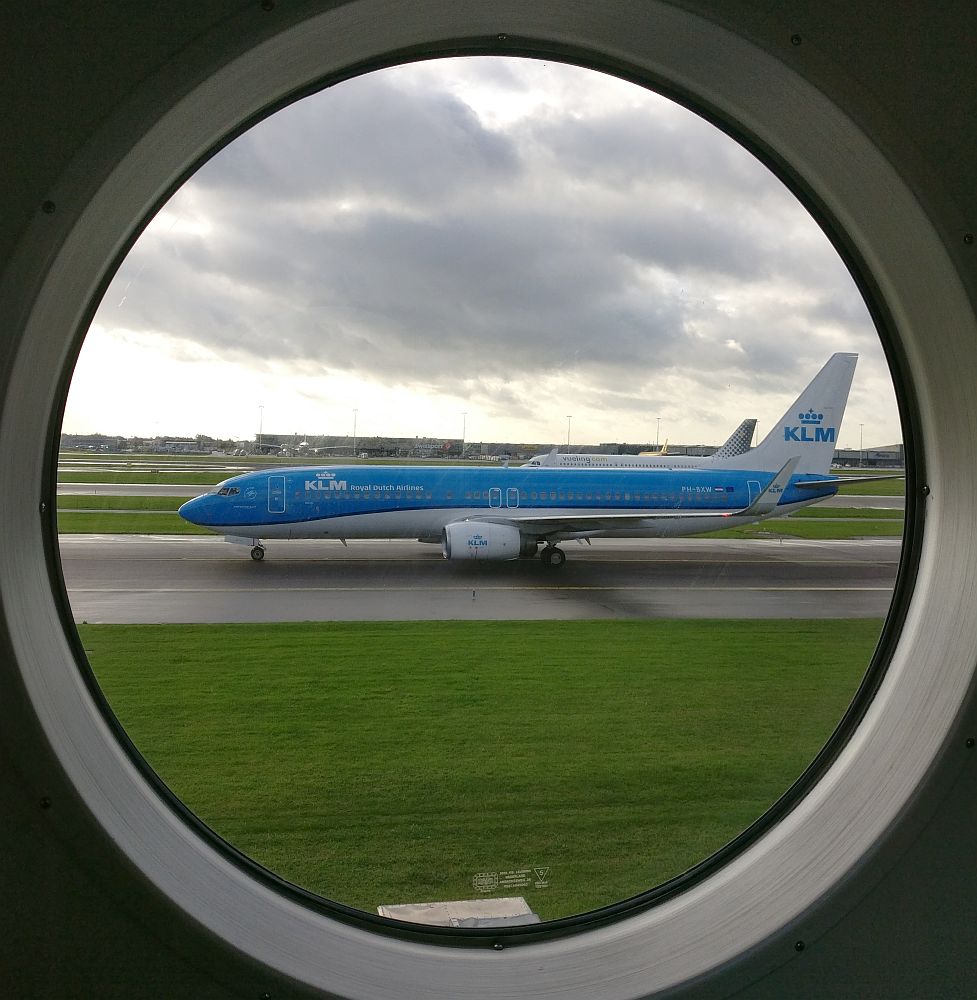
Disclosure: This article contains affiliate links. If you click on one and make a purchase, I will receive a small commission.
According to Paloma Zapata, CEO of Sustainable Travel International, 8 percent of global greenhouse gas emissions come from tourism. This includes not only aviation but emissions from all of the other elements of the tourism industry. Think of, for example, your ground transportation and the air conditioning and water heating and laundry at your hotel and restaurants.
So either we have to quit traveling entirely – and I’m just not prepared to do that – or we need to reduce our emissions.
That’s not enough, though. The second thing we need to do is to offset whatever emissions we can’t reduce. In other words, we have to compensate for them in some way.
And thirdly, since not everyone will offset all of the emissions they produce, we need to go further: removing carbon.
Travel guilt
Travel guilt is a thing, particularly when it comes to our impact on the environment. I’ve heard of quite a few people who, even before the pandemic, gave up flying entirely, or who limit themselves to one round-trip a year. Greta Thunberg is the most well-known example: she refused to fly to speak at a climate conference and ended up traveling by sailboat instead.
I certainly feel that guilt. But I also fly a lot – or at least I did before the pandemic grounded me. Some of my flights were for work, and I would extend my stay for blogging purposes. But whether the flight is for work or leisure doesn’t matter; it still pollutes.
I deal with this guilt in a number of ways at home: we have solar panels that reduce our usage of fossil fuels in our home. We have given up beef, since cows produce a lot of methane which contributes to greenhouse gases, and we eat more vegetarian meals than we ever used to. I do my best to reduce our use of plastic packaging. We drive a hybrid car.
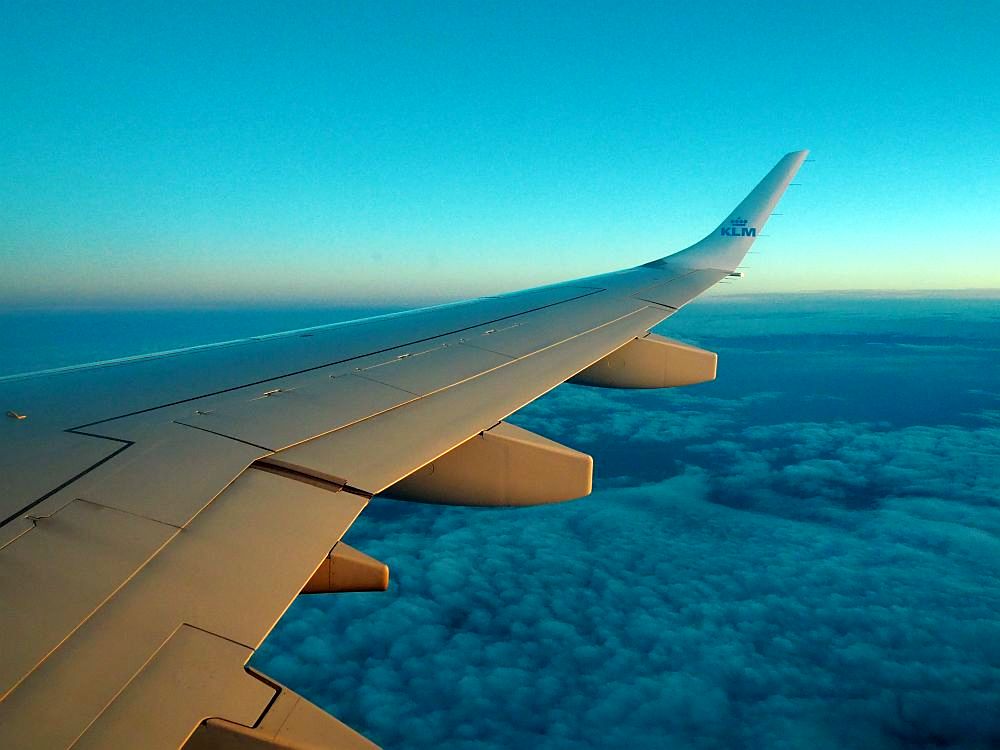
Yet the guilt remains. My husband has decided not to fly more than once a year, but I haven’t yet committed to that limit.
Sustainable travel isn’t just about climate neutrality. It is a more holistic idea that includes supporting the people, the community and the economy of the places we visit at the same time as working toward net zero emissions. You can read a really complete explanation of many forms of sustainable travel here – it’s a commercial tour provider’s site, but the article is very complete and clear. Here’s another very comprehensive article about sustainable travel by a fellow blogger.
In this article, I’d like to look just at flying: a) ways to reduce your carbon footprint while flying, b) carbon offsetting and c) carbon removal. Of course, we do a lot more things when we travel that contribute to carbon emissions. Later, in one or more separate articles, I’ll present more ways to reduce your carbon footprint when you travel, as well as to support local communities and economies.
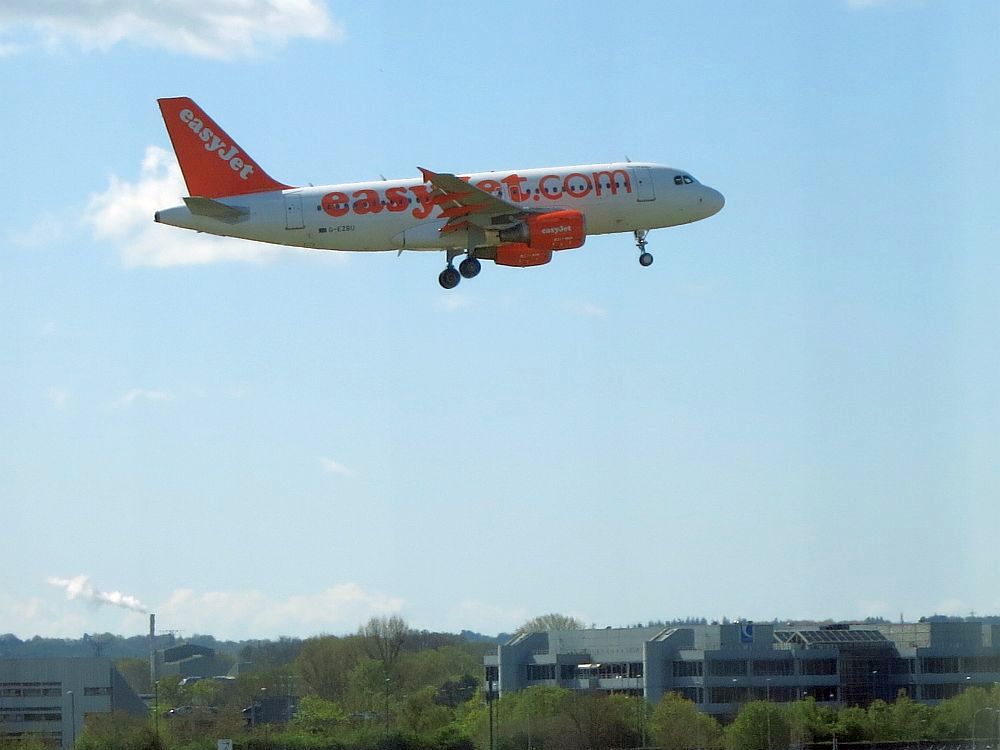
Reducing your carbon footprint when you fly: some tips
While it’s not truly sustainable air travel, there are some small ways in which you can reduce your emissions even when you fly. Often, this has to do with which flight you book. Here are some tips:
- Choose low-impact travel to the airport: take a train, for example, instead of driving. If you must drive, a shared taxi or shuttle bus is better than private.
- Book a non-stop flight. Airplanes emit the most as they take off and land.
- If there is no non-stop flight to your destination, do one leg of the trip by train or car. For example, if you’re flying from Amsterdam to Martinique, there’s a stopover in Paris. Don’t take two flights; instead, take a train to Paris.
- Book a flight that is likely to be full. A half-empty plane is less efficient and, calculated per person, you’re emitting more.
- Fly economy. In business class or first class, you take more room and more resources so your per-person emissions are higher. (For real efficiency, airlines should eliminate business-class and first-class altogether. If no one ever bought those seats, they would stop offering them. And I admit that, given how uncomfortable economy class is, I probably wouldn’t turn down an upgrade to business if it was offered to me. If I could afford to fly business, I’d find it very hard to resist! This is why airlines won’t ever eliminate business and first class, unfortunately.)
- Pack light. The less weight the plane is carrying, the less it emits.
- Choose eco-friendly airlines that use the newest airplanes, which are generally better in terms of energy-efficiency and emissions. Some airlines are working to reduce their use of disposables in their in-cabin service, and are doing things like reducing seat weight for greater fuel efficiency or using more bio-fuels. Look for those.
- Slow travel is better than fast travel. Don’t jet off from city to city, but rather stay and get to know a single place well.
- Use Skyscanner to search for your flights. Check the box (bottom left on a desktop) to show flights with lower emissions, which finds the eco-friendlier flights for you.
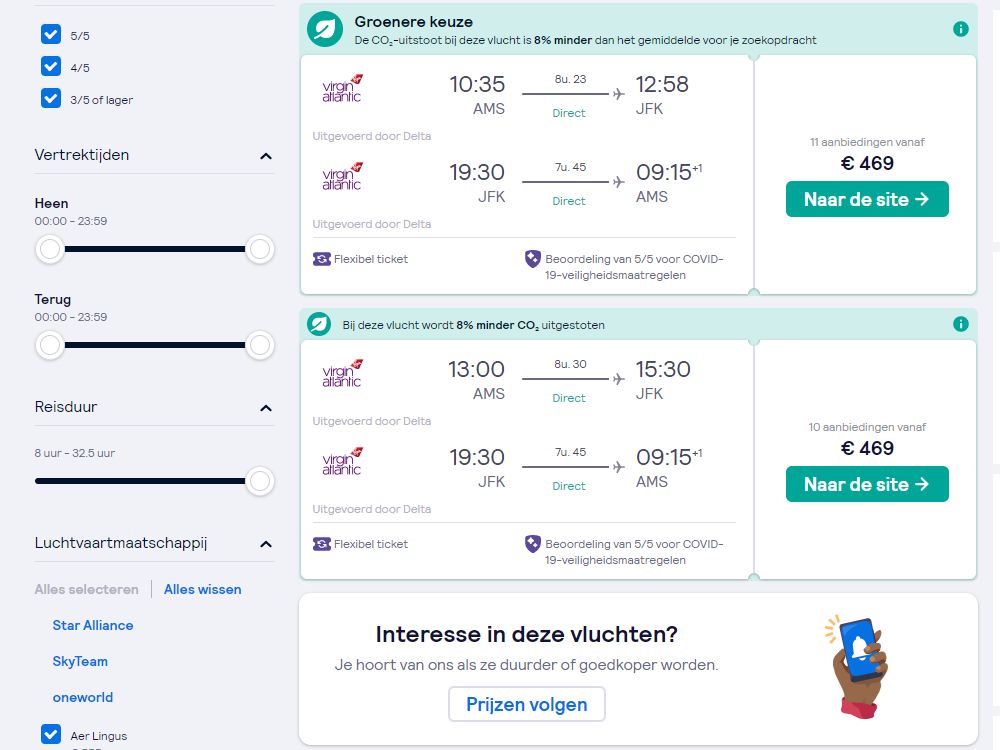
Carbon offsetting
Carbon offsetting is the idea that you compensate the world for the carbon and other greenhouse gases that you emit into the atmosphere. Flying is, for travelers, the biggest chunk of our total emissions, so it’s the one that gets talked about the most.
Carbon offsetting usually involves setting up and supporting projects that will have the net result of reducing greenhouse gas emissions through, for example, supporting wind farms or planting trees to remove CO2 from the air.
It’s hard, though, to know whether a project is legitimate and actually reduces greenhouse gases. If a non-profit buys a piece of deforested land in the Amazon rainforest and replants it, it may not help at all if no effort is going into stopping deforestation in other parts of the rainforest. The best projects benefit the community and local economy as well, making the project sustainable so that the community will have the incentive to ensure the project continues. Here is an interesting article discussing the limitations of carbon offsetting.

How much carbon should I offset?
It’s not hard to figure out how much carbon to offset.
- On this Air Miles Calculator site you can type in your departure and arrival airports to figure out how far your flights will take you.
- Make sure to double it if you’re traveling round-trip.
- Take the result and use this Sustainable Travel International calculator to see how much carbon your flight will emit.
- You can then pay a carbon offset provider by clicking “offset footprint” on the same site. Or you can go and find an offset project of your choice.
As an example, I typed a one-way flight between JFK airport in New York City and LAX in Los Angeles into the air miles calculator. The result is 2475 miles. Entering that number into the carbon footprint calculator generated a result of 1213 pounds of CO2 produced. The cost to offset if I use the same site is $7.10.
Some other articles you might like:
Finding carbon offset providers
If you don’t want to use a site like Sustainable Travel International to take care of your carbon offset, you’ll need to choose your carbon offset provider yourself. Make sure to look for a 3rd-party verification like Gold Standard, American Carbon Registry, Verified Carbon Standard, Plan Vivo, or The Climate, Community and Biodiversity Standards. They check to make sure that the carbon offset company you’re considering isn’t just a pure tree-planting program – or worse, a scam – but rather takes a holistic, long-term, sustainable approach that serves people and community as well as environment.
All of this calculating and researching before every flight is a lot of trouble and, to be honest, I’m too forgetful. That’s why I appreciate when an airline offers me the opportunity to pay for carbon offset. It makes it easy to do: usually a simple check box as you book the flight. The airlines carry out the kind of due diligence that I often mean to do, but don’t get around to.
The best thing would be if carbon offsets were built into all airfares at all airlines, rather than being an opt-in system. (And train and bus fares too, for that matter. And gasoline prices, home heating, etc.) Airlines all over the world could be required to offset their emissions. If they did, airfares would likely go up. This would increase their incentive to, for example, adopt bio-fuels, run the most efficient planes, and so on, to keep their prices down despite the added offset price and to help reduce the cost of offsetting. Truly sustainable air travel, then, could become a reality.
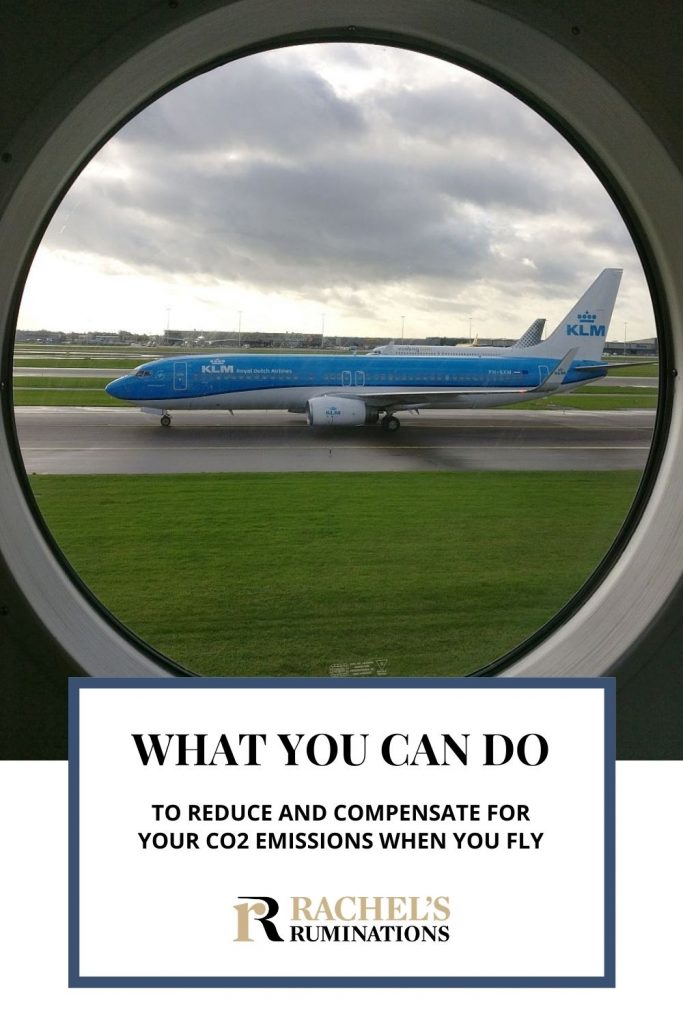
What about carbon removal?
The problem with the whole carbon offset movement is that it won’t make up for all of the world’s emissions. Even if airlines were required to pay the offsets for every passenger, it would only compensate for flying, not all the rest of our activities that produce greenhouse gases.
Carbon removal is the next step. Replanting is a form of removal, since it helps remove CO2 from the air. It’s not happening fast enough, though, to remove enough. Through the Impact Travel Alliance, I became aware of a non-profit organization called Tomorrow’s Air, a collective focused on carbon removal. Tomorrow’s Air works with a company called Climeworks. They build machines that use renewable energy (geothermal and waste heat) to take carbon dioxide out of the air. At their site in Switzerland they sell the carbon on for industrial uses. At their Iceland site, they inject it into the ground, where it is mineralized. In other words, it turns solid.
It’s clear that carbon removal will need to be done on a far greater scale worldwide until we can reach carbon neutrality by using alternative energy sources. More companies will get into the business of carbon removal, developing increasingly efficient ways of doing it. In 2021 Elon Musk announced the XPrize Carbon Removal contest, offering $100 million for practical carbon removal solutions. Perhaps something will come of that.
The problem will be paying for carbon removal. We can help in our small way by, along with carbon offsetting, contributing to carbon removal as well.
I have subscribed to Climeworks to purchase carbon removal on a monthly basis. It’s not a lot, but it’ll help. I encourage you to purchase carbon removal too!
What to do now
In the meantime, when airlines offer carbon offsets, I will continue to pay for them. For sustainable air travel to truly happen, both efforts – offsetting and removal – need to happen at the same time, along with improvements in aviation technology. If you fly, please do the same!
Read this post too: Sustainable travel tips: Part 2 – Land or sea.
Do you pay for offsets or avoid flying? What are your thoughts on the emissions that aviation produces? Add a comment below!
My travel recommendations
Planning travel
- Skyscanner is where I always start my flight searches.
- Booking.com is the company I use most for finding accommodations. If you prefer, Expedia offers more or less the same.
- Discover Cars offers an easy way to compare prices from all of the major car-rental companies in one place.
- Use Viator or GetYourGuide to find walking tours, day tours, airport pickups, city cards, tickets and whatever else you need at your destination.
- Bookmundi is great when you’re looking for a longer tour of a few days to a few weeks, private or with a group, pretty much anywhere in the world. Lots of different tour companies list their tours here, so you can comparison shop.
- GetTransfer is the place to book your airport-to-hotel transfers (and vice-versa). It’s so reassuring to have this all set up and paid for ahead of time, rather than having to make decisions after a long, tiring flight!
- Buy a GoCity Pass when you’re planning to do a lot of sightseeing on a city trip. It can save you a lot on admissions to museums and other attractions in big cities like New York and Amsterdam.
- Ferryhopper is a convenient way to book ferries ahead of time. They cover ferry bookings in 33 different countries at last count.
Other travel-related items
- It’s really awkward to have to rely on WIFI when you travel overseas. I’ve tried several e-sim cards, and GigSky’s e-sim was the one that was easiest to activate and use. You buy it through their app and activate it when you need it. Use the code RACHEL10 to get a 10% discount!
- Another option I just recently tried for the first time is a portable wifi modem by WifiCandy. It supports up to 8 devices and you just carry it along in your pocket or bag! If you’re traveling with a family or group, it might end up cheaper to use than an e-sim. Use the code RACHELSRUMINATIONS for a 10% discount.
- I’m a fan of SCOTTeVEST’s jackets and vests because when I wear one, I don’t have to carry a handbag. I feel like all my stuff is safer when I travel because it’s in inside pockets close to my body.
- I use ExpressVPN on my phone and laptop when I travel. It keeps me safe from hackers when I use public or hotel wifi.





What great ideas for sustainable air travel. Now I am glad we drive to Mazatlan instead of flying! And that we have not flown for three years now! Thanks for the introduction to Sustainable Travel International.
These are all very good tips and I’ll definitely introduce some of them wherever possible. I had already eliminated long haul press trips before the pandemic. No more short trips to Asia or anywhere else but I can definitely do more.
I feel that same travel guilt. I miss traveling so much. Environmental issues are important to me, so I try to act responsibly. Thanks for these additional ideas and insights.
A most interesting read and well-researched article!
Thank you!
Great tips Rachel! Indeed carbon offsetting is not enough, but it is important to speed up the structural changes in the various industries. Just one correction, although I fear it may alarm you. We’d still need carbon removal even if everyone offsets completely, today. Because what humanity has already released in the past several decades is enough to keep the planet warming.
Yes, I’ve heard that. What I’d really like to see is the wealthier governments committing to both carbon reduction and large-scale carbon removal. It won’t be enough unless a lot more effort is put into it.
Very informative and important article, Rachel. It’s definitely challenging to travel and live in a way that’s sustainable. I will check out the resources you suggest.
Rachel, would love more ideas on offsetting travel. We’ve just booked a trip with a group of friends that’s not using sustainable hotels, etc. I wasn’t the one who put the trip together, so, though I’m excited to be with the group, I’m feeling guilty about the travel.
I’ve been meaning to write a whole series about other aspects of travel and how they can be made a bit more sustainable. The problem is finding the time … but I’ll work on it!